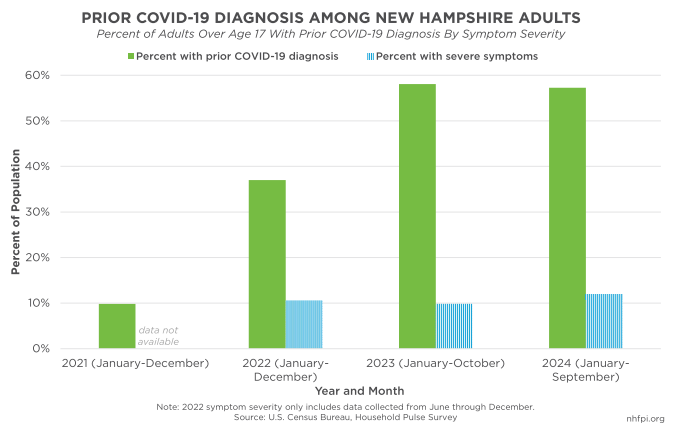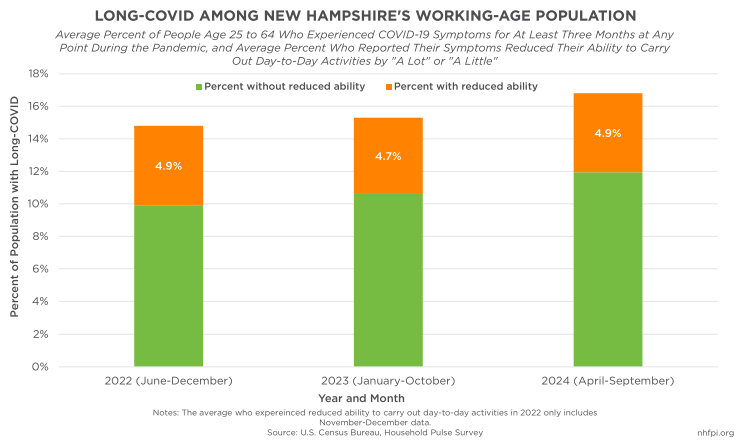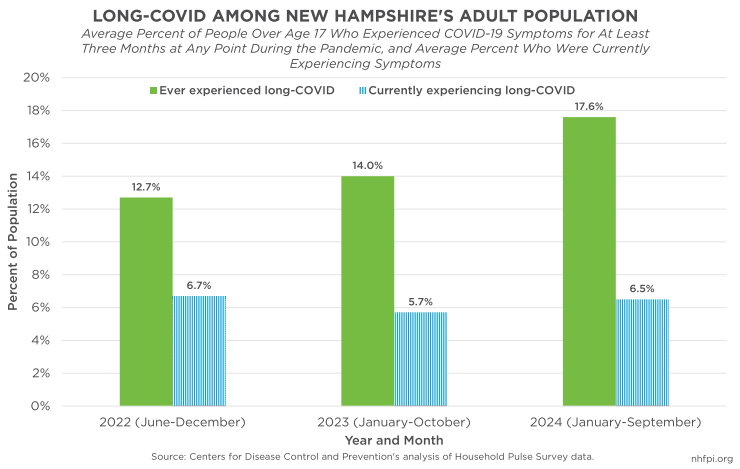During the COVID-19 pandemic, many workers left the state’s labor force as business closures made many temporarily unemployed, while others may have retired earlier than anticipated or shifted from paid work to caring for family members. In addition, longstanding symptoms resulting from initial COVID-19 infections and Post-Acute COVID-19, more commonly known as “long-COVID,” may have kept several thousand Granite Staters from returning to work. Based on U.S. Census Bureau data, approximately 22,400 New Hampshire residents with long-COVID symptoms may have had their work impacted during the first three years of the pandemic. About 9,300 Granite Staters with current long-COVID symptoms may still experience impacts to their work, with approximately 5,300 workers reducing their hours and an estimated 4,000 leaving the workforce entirely. With an average of only 20,000 residents unemployed and actively seeking work in 2024, long-COVID’s impact on labor force participation may pose a significant challenge to New Hampshire’s economic growth and prosperity.
What Is Long-Covid and Who is Most at Risk?
According to the U.S. Census Bureau’s Household Pulse Survey (HPS), statewide data collected from January through September 2024 revealed that an average of 57.3 percent of New Hampshire respondents received a COVID-19 diagnosis at any point since the start of the pandemic, nearly six times the average rate of 9.8 percent during 2021. Among the three out of five respondents who have had COVID-19, an average of 11.9 percent identified that their symptoms were severe. Those with severe symptoms are more likely to be hospitalized, experience worsened health conditions, or need intensive care such as ventilation or intubation. Individuals with severe symptoms also have an increased likelihood of developing long-COVID.
According to the U.S. Centers for Disease Control and Prevention (CDC), long-COVID is defined as “a chronic condition that occurs after and is caused by SARS-CoV-2 infection and is present for at least 3 months.” People experiencing long-COVID have reported more than 200 symptoms, including extreme fatigue, dizziness, changes with taste or smell, sleep disturbances, shortness of breath or breathing problems, persistent cough, fast or irregular heartbeat, and disruptions with memory or “brain fog,” among others. Those who have had long-COVID are also more likely to experience new or worsened health problems such as diabetes, respiratory and heart conditions, blood clots, neurological conditions, and mental health concerns, including depression and anxiety. Long-COVID can occur for months or years and is currently considered a disability, according to the U.S. Department of Health and Human Services.
While anyone can experience symptoms and complications, particular groups of people may be more likely to develop long-COVID. Individuals at higher risk include women, those identifying as Hispanic or Latino, those who were hospitalized or received intensive care during their COVID-19 infection, those with an underlying chronic health condition, older adults aged 65 or older, and those who did not receive a COVID-19 vaccination. According to a CDC analysis using HPS data from 2024, an average of about one in four (26.8 percent) Granite Staters who had COVID-19 at any point since the pandemic began in 2020 went on to develop long-COVID; this likelihood was slightly lower than the national average of 30.2 percent, or close to one in three people.
Long-Covid’s Initial Impact on the Workforce
According to a Brookings Institution analysis from August 2022, approximately two to four million people may have been out of the nation’s workforce due to long-COVID, contributing to a total of up to $230 billion in lost wages during that year. To calculate these estimates, Brookings used three key measures. First, researchers utilized HPS data to determine what percentage of working-age adults experienced long-COVID symptoms. Second, the researchers used national labor force participation rate to determine the percentage of working-age adults that would have been in the labor force during that year. Finally, the Brookings researchers drew on multiple national and international studies to estimate the percentage of people with long-COVID who may have been kept out of the workforce, including those who only reduced their hours.
Other analyses uncover similar impacts on the nation’s workforce, as well as provide additional insight into lasting ramifications of long-COVID. According to a July 2022 analysis from a Harvard University researcher using a different methodology from the Brookings study, around 3.5 million people were out of the workforce due to long-COVID, contributing to around $200 billion in lost potential earnings per year. A smaller study using survey data from February 2021 through July 2022 found that those with long-COVID were less likely to be employed or working full-time. According to a September 2022 analysis from the National Bureau of Economic Research, those who were out of work for at least a week due to a COVID-19 diagnosis were approximately 7 percentage points less likely to still be in the labor force a year later compared to those who did not leave work for health reasons. A more recent 2024 study analyzing data collected from people three months after their COVID-19 diagnosis in 2020-2022 found that about 7.2 percent missed at least ten days of work due to their infection, while 13.9 percent reported not returning to work.
Using Brookings’ methods applied to New Hampshire-specific data produces estimates of the number of Granite Staters that may have been out of the labor force due to long-COVID from the start of the pandemic through 2022. According to the U.S. Census Bureau’s Population Estimates Program, 742,296 Granite Staters were between the ages of 25 and 64 in 2022, which includes the ten-year age groups with the highest typical labor force participation rates, referred to as “working age” in this analysis. HPS survey data from 2022 revealed that approximately 14.8 percent of New Hampshire’s working-age population, or about 109,860 people, experienced long-COVID at some point since the pandemic began. Using the New Hampshire Employment Security’s 2022 labor force participation rate among those age 25 to 64 (78.6 percent), around 86,350 working-age adults in the state’s labor force would have experienced long-COVID at any given point from 2020 to 2022.
While close to 86,500 working-age adults in the state may have experienced long-COVID during this time, not every New Hampshire worker with long-COVID would have left the labor force entirely. Varying symptom severity, flexibility with remote work and other employer accommodations, and financial hardship, particularly among Granite Staters with low or moderate incomes, may have kept adults with long-COVID in the workforce despite their illness. To better account for workers who may have only reduced their hours, Brookings utilizes research from a July 2022 Federal Reserve Bank of Minneapolis analysis. Using nationally representative longitudinal data from the University of Southern California’s Understanding Coronavirus in America Survey (2020-2021), the Federal Reserve Bank of Minneapolis estimated that approximately 25.9 percent of those with long-COVID had their work impacted; of those individuals about 57 percent remained employed, while around 43 percent left the work force entirely, although both these estimates are subject to significant statistical uncertainties. Among the estimated 57 percent of workers who remained employed, they reduced their hours by an average of ten hours a week.
The Federal Reserve Bank of Minneapolis’s estimate of almost 30 percent whose work was impacted aligns closely with NH-specific data. According to 2022 HPS data for the Granite State, approximately 33 percent of those aged 25 to 64 who ever experienced long-COVID identified that their symptoms reduced their ability to carry out day-to-day activities.
When applying the Minneapolis Federal Reserve Bank’s estimates, approximately 22,400 New Hampshire workers aged 25 to 64 with long-COVID may have had their work impacted at any given point from 2020 to 2022. Among this total number, about 12,800 workers may have reduced their hours worked, while around 9,600 Granite Staters may have left the labor force entirely.
Using the Current Employment Statistics’ 2022 average number of hours worked each week among private sector employees in New Hampshire (33.8 hours), as well as the state’s 2022 median hourly wage ($23.04), the 9,617 workers who may have left the state’s labor force translates to about $389.4 million in lost wages for that year alone, assuming that each worker left the labor force for the full year. Further, if the 12,748 workers who reduced their hours reduced them by an average of ten hours each week, this would translate to an additional $152.7 million in lost wages in 2022.
While methodological adaptations from the national Brookings analysis can provide insight into the state’s workforce, these data do not factor in costs of lower productivity resulting from people working when sick, additional health care costs and constraints on the overall health system, and the number of people who may have left work to care for family members who also contracted COVID-19.
Rates of Long-Covid Have Remained Consistent
According to the CDC’s analysis of HPS data, rates of long-COVID among the state’s population have remained relatively consistent over the last three years. As of the first nine months of 2024, an average 6.5 percent of Granite Staters identified that they were currently experiencing long-COVID symptoms at any given time, which was similar to the average 6.7 percent in 2022. In addition, the percentage of the state’s population who has ever experienced long-COVID has increased by almost 5 percentage points since 2022, from 12.7 percent to 17.6 percent in 2024.
Long-COVID has remained relatively consistent in New Hampshire, and national long-COVID trends follow similar patterns. According to HPS data analyzed by the CDC, an average of 5.9 percent of the nation’s population experienced long-COVID symptoms at any given time in 2024, a slightly smaller number than the state’s average of 6.5 percent. Further, 17.9 percent of the nation’s population has experienced long-COVID since the pandemic began, which is approximately the same percentage recorded among New Hampshire’s population in 2024 HPS data.
In addition to continuing rates of long-COVID, one in four people currently experiencing long-COVID report significant activity limitations resulting from their symptoms. According to national HPS data, of those who currently had long-COVID at any given point in 2024, an average 24.0 percent identified that long-COVID symptoms significantly reduced their ability to carry out day-to-day activities; similarly, around 24.9 percent reported such limitations in 2022.
National age-related data can provide insight into long-COVID’s current impact on the New Hampshire labor force. According to the most recent HPS survey data available, collected from August 20 through September 16, an average of 5.9 percent of the nation’s population age 18 to 60 identified that they were currently experiencing long-COVID symptoms. If Granite Staters age 18 to 60 are experiencing long-COVID rates similar to national rates, around 5.9 percent of the state’s working-age population may be currently impacted by long-COVID. Using slightly different age ranges due to data limitations, an estimated 711,929 adults were between the ages of 20 to 64 as of 2023, with about 605,140 of these adults engaged in the state’s labor force as of September 2024.
Since the percentage of those with a reduced ability to carry out day-to-day activities has remained consistent nationally, long-COVID is likely continuing to impact the state’s workforce. Assuming that the Minneapolis Federal Reserve Bank’s analysis has remained true, around 25.9 percent of working-age Granite Staters currently experiencing long-COVID symptoms (about 9,300 people) would have had their work impacted from August to September 2024. Among this number, around 5,300 adults (57 percent) may have reduced their hours, while about 4,000 (43 percent) may have been out of the state’s labor force entirely due to long-COVID.
While HPS data can provide insight into how many Granite Staters may be out of the state’s workforce currently, little is known around how longstanding these impacts may be. People with long-COVID can experience symptoms for months to years and may face continuing barriers to remaining in or re-entering into the workforce due to their condition. One objective outlined in the U.S. Office of Long COVID Research and Practice’s Strategic Framework, updated February 2024, is to further research strategies to prevent long-COVID, as well as expand understanding of treatment opportunities to help those with long-COVID to recover more quickly. In addition, research centering communities of color, people with underlying health conditions, and other groups who are more likely to experience COVID-19 could help ensure enhanced understanding of the full impact on the nation’s workforce, according to the U.S. Department of Labor. While more research is underway, expanded employer accommodations, such as flexible hours and remote work, can help ensure that Granite State workers with long-COVID are able to remain in the labor force and contribute to the state’s economy.
– Jessica Williams, Policy Analyst



